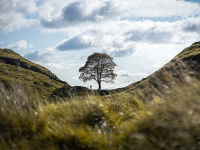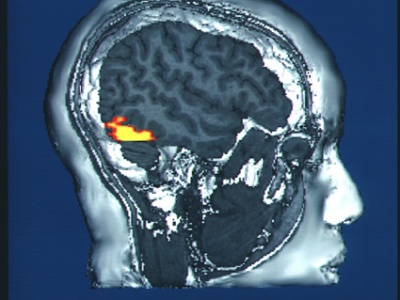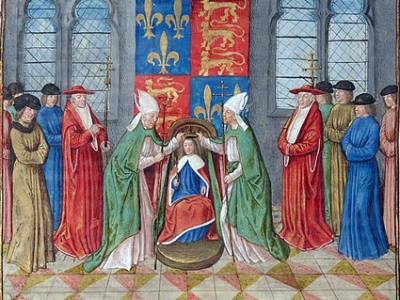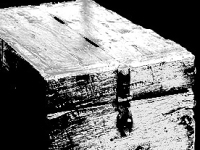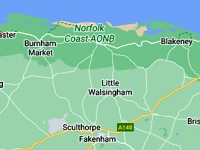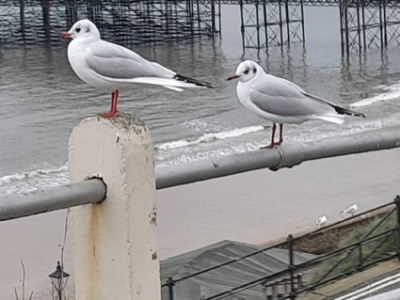The loss of life when the Titanic sank tends to be measured solely in human terms.
The exact number of human fatalities has been a subject of some debate and minor variation in historical records; but it’s generally accepted that 1,517 people died in the disaster. The Titanic was carrying an estimated 2,224 passengers and crew members when, approximately 400 miles south of Newfoundland in the North Atlantic Ocean, she struck an iceberg at around 11:45 p.m. on April 15th, 1912 and sank at around 2.00 a.m. The limited number of lifeboats, poor decision-making by various persons in positions of responsibility and the rapidity with which the huge ship sank contributed to the high death toll.
But there was other life on board the Titanic, aside from human life …
The number of animals on the Titanic was relatively small compared to the tally of human passengers. But although the animals were fewer in number, they were quite varied, being primarily pets owned by passengers, including dogs, cats and possibly a canary, though most sources say the canary disembarked at Cherbourg. In addition there were chickens and other small animals.
A dog show had been planned for later on April 15th; it never took place, of course. Among the dogs, Lady was a Pomeranian belonging to Margaret Hays, a first-class passenger. Margaret was travelling with two friends, Olive Earnshaw and Lily Potter. She was initially unperturbed when a steward told them that the ship had hit an iceberg, as he reassured them that all was well. But Lily was scared, so all three quickly got dressed, wrapping Lady in blankets. As the ship began to sink, Margaret and her companions rushed to board lifeboat number 7, the first to be launched. Historical accounts suggest Lady was smuggled into the lifeboat in a small bag. The dog survived the sinking and made it safely to New York with her owner, after occupants of the lifeboat were rescued by RMS Carpathia.
Kitty, an Airedale Terrier, owned by millionaire John Jacob Astor, (pictured right) did not survive and perished with her owner. It appears that Kitty was kept in the heated kennels situated at the foot of the rearmost funnel (which operated only as a ventilation system for the lower decks).
The kennels were under the control of carpenter John Hall Hutchinson, though, according to most accounts, it was banker Robert W. Daniel (pictured left, with his dog) who released all the animals when sinking appeared inevitable. It was reported by survivors that panicked dogs were seen scrambling up and down the decks of the doomed vessel. Mr Daniel was no doubt most concerned about the fate of his champion French bulldog, exotically named Gamin de Pycombe but known as Pye, which he’d recently purchased for £150. Daniel went down with the ship, but jumped into the water at the last second and was eventually pulled onto a lifeboat, completely naked. He later successfully claimed a £750 insurance payout for his dog.
A prize Pekinese, named Sun Yat-sen after the first President of the Republic of China and owned by Mr and Mrs Henry Sleeper Harper, was more fortunate than Pye. Mr. and Mrs. Harper, Hassab (their interpreter) and the dog were picked up by RMS Carpathia during the morning of April 15th.
There’s no record of its name, but another dog – another Pomeranian (or “Pom Pom” – see example illustrated) – belonged to Martin and Elizabeth Jane Rothschild. Mrs. Rothschild and the dog were helped into Lifeboat 6 by her husband, though he himself was to perish. She managed to hide the dog until the occupants of the boat were rescued by RMS Carpathia. Its crew declined to allow the dog on board at first, but Mrs Rothschild refused to go aboard unless she was allowed to bring her dog with her. The crew eventually relented.
Another female passenger, Anne Elizabeth (“Lizzy”) Isham, who had been on her way to meet her brother in New York, is also said to have insisted that her dog, a Great Dane, be allowed to stay with her. She was already in a lifeboat but was told by the crew that she could not bring such a large dog with her, so the story goes. It’s said that she refused to stay in the boat without her dog, returned to the ship and was never seen again – unless it was her body which was seen, some days later, by Mrs. Johanna Stunke, a passenger on the Bremen. The corpse was floating amid flotsam and jetsam, clutching the body of a large dog. The incident has been disputed and largely discredited, and the disappearance of Ms Isham and even records of her life do seem to call the incident into question. Some claim she never even owned a dog. But how can we be sure of exactly what happened to a woman travelling alone, alone other than with her beloved canine guard dog, in the middle of the night, in the middle of the ocean? In a situation of such chaos, to completely dismiss unsubstantiated rumours is to ignore the reality of a Hell-like scene of terror and mayhem.
Other dogs aboard the Titanic included a fox terrier named Dog, who belonged to William Crothers Dulles, a non-practising lawyer, famed for his horse breeding and his huge collection of equine books and prints. Both dog and owner died in the tragedy, his body being recovered in late April. The dog was never found. Coal magnate William Ernest Carter joined Titanic at Southampton with his wife, Lucille. The wealthy US couple were frequent visitors to Europe, holidaying regularly on the continent. They were accompanied by two family pets, an Airedale and a Pekinese spaniel, the latter probably named Me Too (according to Encyclopedia Titanica). Neither dog survived but Carter made a successful insurance claim on their lives. Another canine casualty that should get a mention is a Chow Chow, owned by Harry Anderson, a stockbroker and yachtsman. There’s no record of his dog’s name; but Mr Anderson too survived and made a successful insurance claim for his dog.
There were also some dogs belonging to crew members. It seems there were probably at least twelve dogs aboard the liner, though, like many aspects of the disaster, the fog of history and the chaos of the tragedy itself have resulted in numerous conflicting accounts, so this is a “best estimate”. It’s clearly significant that, of the known total of twelve dogs on the Titanic, the only three to survive had two common characteristics: first, all were owned by passengers travelling first class, who were allowed to keep their dogs in their cabin; and also all three were small dogs, which made smuggling them into the lifeboats easier. (The influence of class bias in the chances of survival of animals seems to mirror the profile of survivors versus those who drowned: if you were rich, you had a better chance of surviving).
In addition there have been some discredited stories about Titanic dogs. Rigel was reputedly a black Newfoundland dog, known for his strength and swimming abilities. He belonged to the first officer of the Titanic, William Murdoch (pictured left). When the ship struck the iceberg, Rigel is said to have jumped into the freezing water and paddled around for quite some time; he was rescued by one of the lifeboats and later alerted the Carpathia by barking when it approached, helping avoid a collision. It is now generally agreed that not only did Rigel not perform acts of heroism, he never even existed.
I don’t know about you, but when I think of non-human life on a ship, the first creatures that spring to mind are rats. (The notion that rats flee a sinking ship is nothing new, by the way. One of the first references to it is this passage in Edward Stillingfleet’s 1675 An Answer to Mr Cressy’s Epistle: “… have they made any renunciation since, of any of those doctrines which were thought so dangerous then? or are they quite gone from us, and to use Mr. Cressy’s own comparison, like Rats have forsaken a sinking Ship?”).
There’s no doubt that there would have been numerous rats and mice on board the ship, though of course no reliable estimate of numbers is available. In addition there were a few cats reported to be on the doomed vessel. One of the most well-known felines was a ship’s cat named Jenny, owned (some say) by the Titanic’s chief baker, Charles Joughin (pictured).
Jenny became the ship’s mascot after transferring from Titanic’s sister ship, the Olympic, and was allowed to wander around the ship, earning her keep by catching rats and mice.

Although Jenny is believed by many to have survived the sinking, this (again) is the subject of considerable controversy and there are conflicting opinions, some suggesting that she gave birth to a litter of kittens prior to the start of the fateful voyage and disembarked at Southampton. People speculate whether she had some sixth sense about the coming fate of the ship. But a man called Mulholland, one of the stokers who brought Titanic from Belfast to Southampton, told how when they arrived in Southampton he was weighing up whether to take extra work on the Titanic or join a tramp steamer for work that would last a lot longer. He claimed his mind was made up as he saw a cat leave the ship with her kittens and decided it was an omen that all was not well with Titanic. Was this cat Jenny and her kittens?
(I should add that rather more interesting – and undeniable – is the incredible, but true, story of Joughin’s bravery and how he survived the sinking. The gripping, verbatim testimony he gave at the inquiry when interviewed on Day 6 of the British Wreck Commissioner’s Inquiry can be read here.)
In addition to cats and dogs, sources suggest there were various birds, including parrots, as well as other small animals such as turtles and rabbits. A canary is known to have been on board for a time, but disembarked at Cherbourg. Most of these animals were kept as pets by the passengers and were not part of any official cargo or livestock, though there were almost certainly some (unrecorded) chickens aboard, kept by the crew for meat and eggs.
Ella Holmes White had been visiting Europe with her very close friend, Mary Grice Young. While in France, they acquired some costly live fowl for breeding purposes and brought the chickens – four roosters and hens – onto the ship, where they were kept near the F-Deck kennels, their crows and clucks being heard distantly on other decks via the ventilation funnel. Every day Miss Young, accompanied by John Hall Hutchinson, the ship’s carpenter, ventured below decks to inspect her acquisitions. As an expression of gratitude for his assistance, Miss Young rewarded Hutchinson with a few valuable coins. Sadly, all of her animals drowned.

Indeed, the vast majority of the animals on board did not survive the sinking. The priority was to save human lives. And with the chaos and limited resources available during the evacuation, the fate of animals was mostly overlooked or left to chance.
Credits:
Titanic leaving Belfast with two guiding tugs visible (actually there were five tugs used): Robert John Welch (1859-1936), official photographer for Harland & Wolff; 2nd April, 1912
Information about Marie Grice Young: https://www.encyclopedia-titanica.org/titanic-survivor/marie-grice-young.html
Map – route of Titanic’s first/last maiden voyage, 10th-15th April, 1912: Prioryman, CC BY-SA 4.0 https://creativecommons.org/licenses/by-sa/4.0, via Wikimedia Commons
Other photos: public domain/fair use.
Note:
There is considerable controversy and speculation about a large number of aspects of the Titanic and her sinking. With this in mind, I offer the above only as my best guess as to what are the most reliable descriptions of the animals, people and events involved.



















